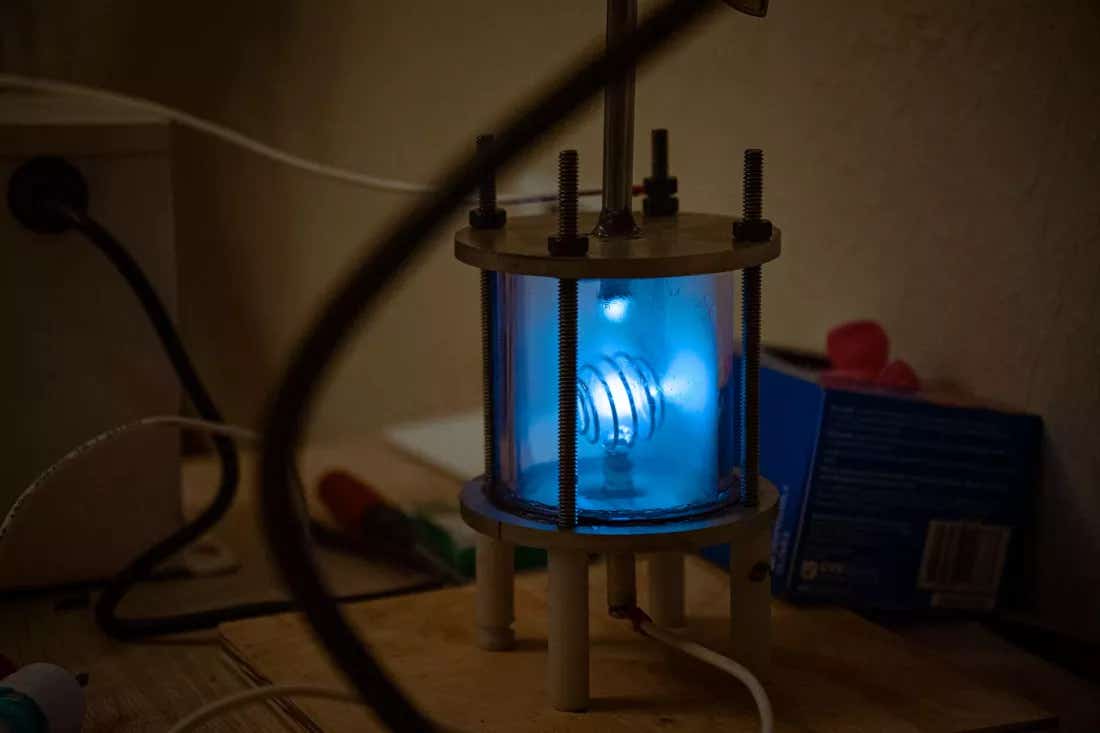Student builds fusion reactor at home using off-the-shelf parts for $2,000
A University of Waterloo student builds a mini fusion reactor in his bedroom with $2,000 worth of parts. Here’s how his creative approach is inspiring others in the quest for fusion.

In just four weeks and with about $2,000, Hudhayfa Nazoordeen, a math major from the University of Waterloo, created a mini fusor using parts he bought online. (CREDIT: Hudhayfa Nazoordeen)
In the competitive race to crack the fusion code, an unexpected participant has gained attention—not a billionaire with a cutting-edge lab, but a university student who built a reactor in his bedroom.
In just four weeks and with about $2,000, Hudhayfa Nazoordeen, a math major from the University of Waterloo, created a mini fusor using parts he bought online. His project might not have produced fusion yet, but his ingenuity and perseverance stand out as he moves closer to understanding fusion technology.
Nazoordeen’s reactor design mirrors that of a tokamak, a common type of fusion device. Instead of the high-tech equipment typically used in fusion research, he powered his fusor with a simple 12kV neon sign transformer. The outcome of his efforts was a setup capable of producing plasma, the state of matter where fusion happens.
Having “zero hardware experience,” Nazoordeen admitted that his first week was mostly spent figuring out which components he needed and sourcing them from suppliers like McMaster-Carr. Week two was dedicated to assembling the main chamber and rectifier circuit, while in week three, he installed the neon transformer and began integrating it into the system.
However, the biggest challenge he faced occurred midway through week three when he had to tackle the vacuum system. Creating a vacuum is crucial because fusion demands incredibly low pressure, allowing nuclei to get close enough to fuse. This process tested Nazoordeen’s persistence more than anything else in the project.
Related Stories:
“This was by far the most annoying part of this project,” he revealed in a thread on X, previously known as Twitter. Tiny leaks in the system required meticulous attention as he worked to seal them all. After several attempts, he successfully achieved a vacuum of 25 millionths of an atmosphere, a critical step in advancing the fusor’s capabilities.
To monitor and control the vacuum, Nazoordeen used an MKS-901p transducer, ensuring that pressure levels remained low enough for potential fusion reactions to occur. Although his reactor didn’t quite reach the point of inducing fusion—meaning it didn’t produce neutrons—it still represents a remarkable achievement for such a small, home-built device.
A significant part of Nazoordeen’s success was thanks to the assistance he received. Other engineers at his university offered their expertise, but a surprising helper was Claude 3.5, an AI chatbot developed by Anthropic. Nazoordeen described how the chatbot was instrumental in interpreting complex datasheets, helping him troubleshoot various aspects of the build.
“I fed Claude all my datasheets, and it helped a ton with this,” Nazoordeen noted, underscoring the increasingly important role that AI plays in modern scientific and engineering projects.
While Nazoordeen’s current fusor didn’t achieve full fusion, he remains hopeful. He’s waiting on additional funding to further develop the project and build what he calls the “full fusor.” More advanced reactor concepts or significant engineering adjustments could push his design into neutron-producing territory, but that remains a future goal.
Nazoordeen’s project draws inspiration from similar efforts by other young innovators. One notable example is Olivia Li, an engineer from the University of Toronto. Last year, she made headlines for constructing her own fusion reactor in her New York City apartment, using deuterium gas extracted from heavy water. Like Nazoordeen, Li tackled the complex challenge of building a fusion device in a non-traditional setting and with limited resources.
Li expressed admiration for Nazoordeen’s work, emphasizing how rare it is for someone to take on such a project and see it through.
“A lot of people I’ve talked to have been excited about building a fusion reactor,” Li shared in a post on X. “Hudzah is the only person to have actually went on and executed!” She went on to provide a link to a write-up aimed at helping anyone else interested in building their own fusor at home.
in a couple weeks, i built a nuclear fusor in my bedroom – with zero hardware experience
— HudZah ⁂ (@hud_zah) August 23, 2024
the secret? Claude sonnet 3.5 + projects
a glimpse into the process below pic.twitter.com/H4261f5bCy
Fusion remains an incredibly difficult technology to master, even for the world’s top labs and researchers. Yet, efforts like those of Nazoordeen and Li demonstrate the growing accessibility of this field to independent researchers.
While the road to producing practical, sustainable fusion energy is still long, such grassroots projects offer hope that the future of energy innovation might not be limited to the wealthy and powerful. Instead, it could be fueled by creativity, persistence, and even a bedroom workshop.
Note: Materials provided above by The Brighter Side of News. Content may be edited for style and length.
Like these kind of feel good stories? Get The Brighter Side of News' newsletter.
Joshua Shavit
Science & Technology Writer | AI and Robotics Reporter
Joshua Shavit is a Los Angeles-based science and technology writer with a passion for exploring the breakthroughs shaping the future. As a contributor to The Brighter Side of News, he focuses on positive and transformative advancements in AI, technology, physics, engineering, robotics and space science. Joshua is currently working towards a Bachelor of Science in Business Administration at the University of California, Berkeley. He combines his academic background with a talent for storytelling, making complex scientific discoveries engaging and accessible. His work highlights the innovators behind the ideas, bringing readers closer to the people driving progress.



